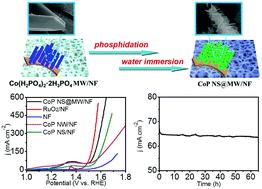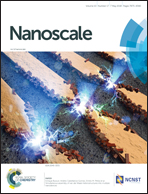Fabrication of hierarchical CoP nanosheet@microwire arrays via space-confined phosphidation toward high-efficiency water oxidation electrocatalysis under alkaline conditions†
Abstract
In spite of recent advances in the synthesis of transition metal phosphide nanostructures, the simple fabrication of hierarchical arrays with more accessible active sites still remains a great challenge. In this Communication, we report a space-confined phosphidation strategy toward developing hierarchical CoP nanosheet@microwire arrays on nickel foam (CoP NS@MW/NF) using a Co(H2PO4)2·2H3PO4 microwire array as the precursor. The thermally stable nature of the anion in the precursor is key to hierarchical nanostructure formation. When used as a 3D electrode for water oxidation electrocatalysis, such CoP NS@MW/NF needs an overpotential as low as 296 mV to drive a geometrical catalytic current density of 100 mA cm−2 in 1.0 M KOH, outperforming all reported Co phosphide catalysts in alkaline media. This catalyst also shows superior long-term electrochemical durability, maintaining its activity for at least 65 h. This study offers us a general method for facile preparation of hierarchical arrays for applications.

- This article is part of the themed collection: Nanoscale Most Popular Articles


 Please wait while we load your content...
Please wait while we load your content...